How to prune a pine tree?
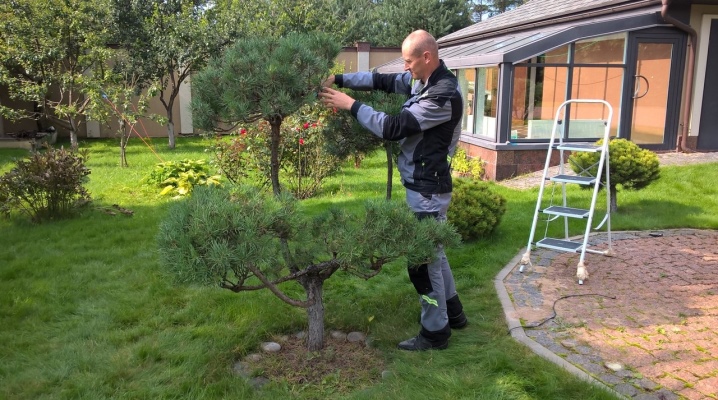
Pruning trees is a regular procedure that should not be neglected. This applies to almost all gardeners, in particular those who have decided to plant a tree such as pine on their site. Not everyone knows how to put a given tree in order by pruning, at what time of the year it is better to carry out such a procedure, and also what should be the subsequent care of the pine. All these nuances will be discussed in detail in this article.

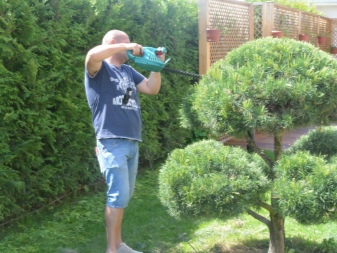
What is pruning for?
There are various purposes for which the pine should be pruned. One of them is the rejuvenation of the tree, which already has many dry branches. In this case, the pruning procedure will contribute to the emergence of new young shoots, help to make the crown more fluffy, and give the tree a second life.
Besides, dry branches must be removed in time also due to sanitary purposes... If there are many such dry growths on a tree, the risk of fungal diseases on it increases. And also in the absence of pruning, dry branches can fall, and especially large ones can cause material or even physical damage.

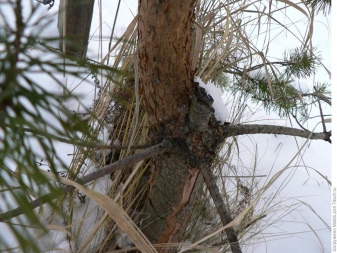
In addition to the importance of the tree branches being more luxuriant, it is also worth taking care that the pine tree does not grow strongly upward and does not shade the area with itself. This also requires pruning.
A tree that is too large in height does not look so elegant in a private area. In addition, it can deprive other plants of the necessary access to sunlight.
There is also curly pruning, which contributes to the formation of the splendor of the crown, maintaining its shape, and also slowing its growth. For this purpose, such pines are especially often cut, which play the role of a hedge on the site.
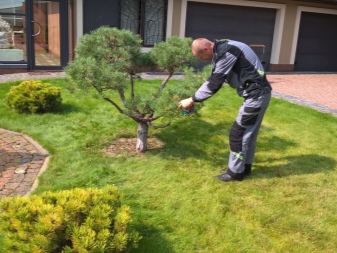
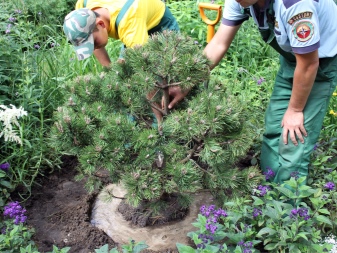
The right time
It is very important to choose the right time to prune a tree such as pine. And for each pruning purpose, a particular time of year is best suited. Spring, for example, is a good time to prune trees in order to form the crown and make the top more compact. At this time of the year, sap flow is activated in pines, which explains the favorable pruning process.
The first month of summer is the ideal time to prune those young shoots that break the outline of the pine crown. Do not delay this procedure until July or August, because during these months, renewed needles are formed on the tree, and because of the shortened branches, there is a risk that it will turn yellow. The pinching is carried out in the first decade of June, since it is during this period that the growth of young shoots stops.
In the autumn, it is better to carry out pruning aimed at rejuvenating the pine. On shortened very old sections of the tree, buds may appear in the spring, which will stimulate the appearance of new branches.
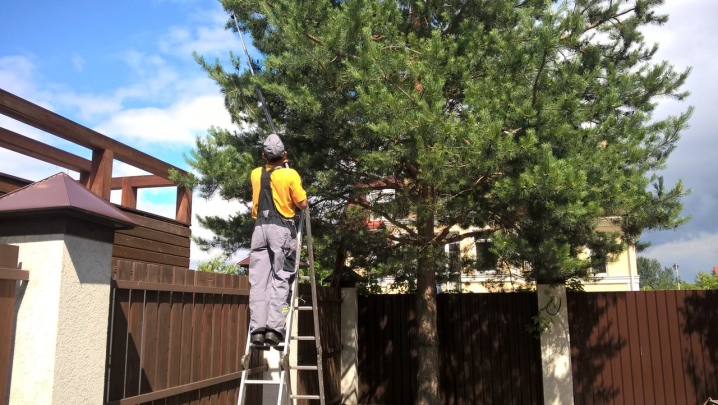
Just remember that it is better to carry out the procedure for pruning branches in early autumn. During periods of cold weather, the regeneration of the cuts is more difficult, since at this time the tree does not release the cambium necessary for this process.
but there are times when pine pruning is urgently needed... This is due to the formation of a large dry branch, which can be harmful by its fall. Therefore, you can get rid of dried branches throughout the year.

Fundamental rules
There are a number of nuances that need to be considered in order to to correctly form not only a beautiful, but also a healthy pine crown in the garden.
- It is important to work carefully so as not to damage the dormant buds of the tree. Subsequently, it is from them that 3 or 4 strong shoots are formed, giving the crown splendor and greater roundness.
- Take care of the cleanliness of the tool with which you will perform the cutting procedure. Due to contamination, there is a risk of infecting both an adult and a young tree.
- In order not to damage the pine, you should cut off about 1/3 of the total mass of the branches.
- To prevent harmful bacteria from entering the sections, and subsequently rot does not form, it is important to treat the shortened areas with copper sulfate. And also for these purposes, a garden pitch is used, especially when it comes to large cuts.
- Avoid pruning too often, or the tree may weaken and there is a risk of disease.
- Pay special attention to the condition of the lower branches, as these are where you can most often see signs of dryness.
- It is permissible to combine pruning of rejuvenating and revitalizing species in one procedure. However, it is important not to do this procedure in the autumn, otherwise the growth of needles will slow down significantly.
- Do not prune pine needles if after spring pruning some branches still grow intensively. Otherwise, your pine tree may turn yellow and look unaesthetic.
- The optimal pruning tool is garden shears with long, sharp blades.

Step-by-step instruction
It is worth remembering that the strategy of this process depends on how you need to prune the Scots pine on the site. If you are going to prune this tree with your own hands, then it is worth studying special schemes that tell you step by step how to form a pine crown in one way or another.
If you are thinning a tree, you should first carefully examine it and find all the shoots that should be removed. They are removed in such a way that the length of the shoot does not exceed 5 cm. It is important that the cut is carried out at a slight slope, as this minimizes the likelihood of deformation of the trunk and helps to balance it.
The branching process begins at the top of the pine.

However, sanitary pruning, on the contrary, starts from the bottom of the tree, among which there may be branches that are already strongly bent to the ground. Due to such processes, dampness is formed, and the risk of fungal growth increases. Next, you should get rid of broken or damaged branches, and they are cut off with the help of a delimber or saw already close to the trunk or other branch. Next, the cut is processed either with resin taken from the cut branch, or with garden pitch.
Pruning the upper part of the tree is carried out when it reaches a height of 1.5 m. The maximum permissible indicator for pine is 1.8 m. In this case, the tree can be both young and adult. The upper part of the trunk, along with the branches, is removed during this procedure. After that, you should get rid of the upper neighboring shoots, which can serve as a replacement for the top of the pine.
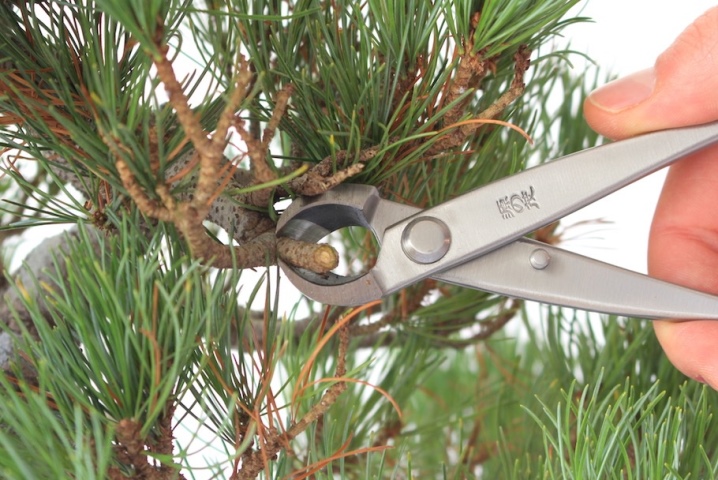
If you plan to use pine trees in the country as a hedge, it is important to cut off its branches every year, as well as shorten the top in a timely manner. It is due to these procedures that the shoots actively grow on the sides, and subsequently they form a dense crown, which serves as an element of the hedge. To cut a hedge, you should use a tool such as an electric-type scissors. They are trimmed after the crown has acquired sufficient density.
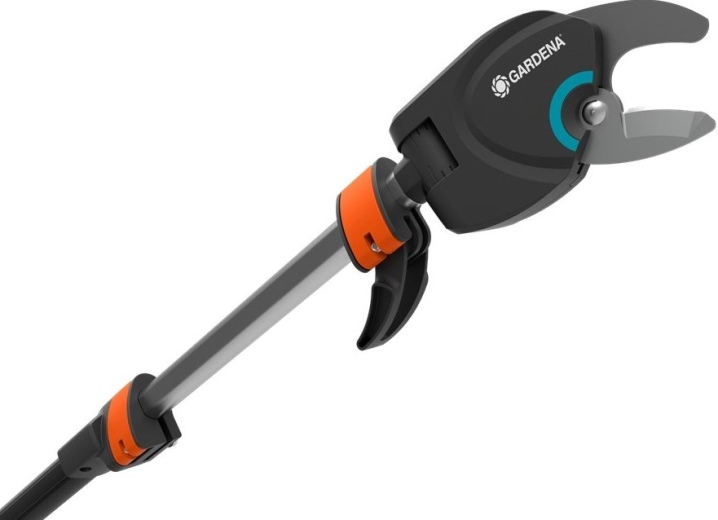
The formation of the crown of a decorative shape often comes from the Japanese style of cutting trees called nivaki. It can be carried out during the entire period of pine growing, having previously determined the desired crown shape and height. As the tree grows, unwanted branches need to be removed, creating the necessary outlines. Every year, you should remove half the length of young shoots, pinch the candles and shorten part of the needles.
If you want to create a complex shape on your pine tree, for example, a circle, a pyramid or even an asymmetry, then you should contact an experienced specialist.
It can be extremely difficult to cut a tree on your own using this technology.
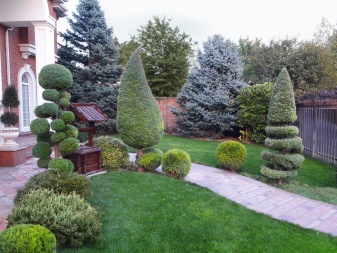
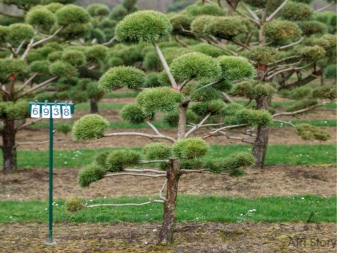
Pinching features
It is necessary to pinch the pines so that after pruning they do not become too lush and spreading. This process is carried out as follows:
- an escape is clamped in the left hand between the index and thumb;
- then you need to twist the tip of the shoot with your right hand - when the shoot is twisted in this way, the upper bud becomes the leading one, since this process creates an oblique fracture line;
- unnecessary shoots can be twisted completely.
Pruning without pinching the tree is not enough, because it is due to it that new buds awaken in the spring, the shoots of which are pinched in the same way after a year. But it is very important to ensure that you do not miss the necessary areas during the pinching, otherwise long branches will form from them, which violate the structure of the crown.
Tools that can help with this procedure are pruning shears and a garden saw or hacksaw that can be used for particularly large branches.

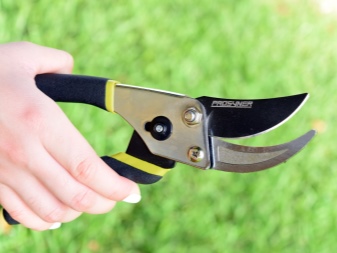
Further care
In addition to the pruning procedure itself, the subsequent care of the tree is also important, which will help it recover from this procedure with minimal losses. Let's list the main restorative actions on the part of the pine owner.
- Feeding with phosphorus and mineral fertilizers is necessary if the tree visually seems to be exhausted after the pruning procedure.
- It is imperative to maintain a moisture balance, avoiding drought or overflow. For pine, the optimal dose of water is a couple of irrigations per month.
- And also after stress, various strengthening stimulants help the tree recover.
- After the pinching procedure, spray the tree with a urea solution, which will produce a disinfecting effect and serve as a top dressing.
- Remove dried needles regularly (preferably in spring). Pay particular attention to those areas of the tree where ventilation is difficult to reach.
Thus, the need for pruning garden pines is undeniable. It is with the help of it that you can not only prolong the life of the tree, but also protect yourself and your loved ones from unwanted incidents. And the tree itself will thank you for your care with its aesthetic appearance and pleasant coniferous aroma.
How to do strong pine pruning correctly, see below.



































































The comment was sent successfully.